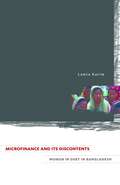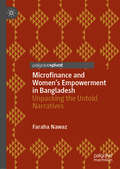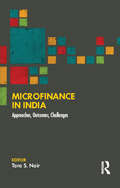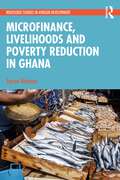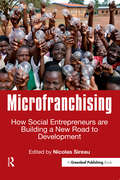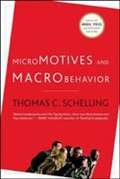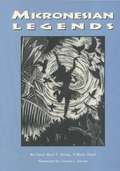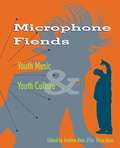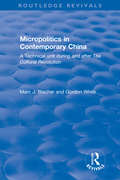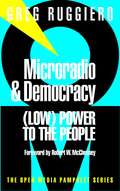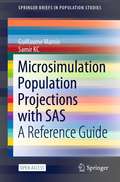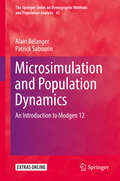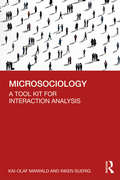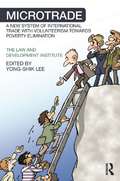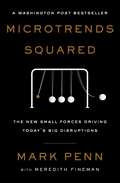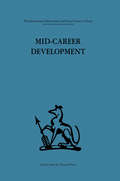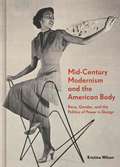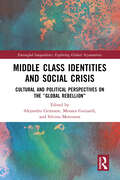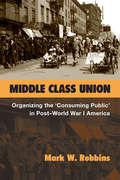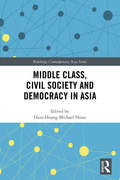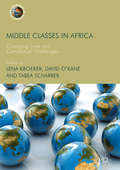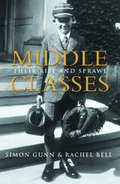- Table View
- List View
Microfinance and Its Discontents: Women in Debt in Bangladesh
by Lamia KarimA feminist critique of the much-lauded microcredit process in Bangladesh In 2006 the Grameen Bank of Bangladesh won the Nobel Peace Prize for its innovative microfinancing operations. This path-breaking study of gender, grassroots globalization, and neoliberalism in Bangladesh looks critically at the Grameen Bank and three of the leading NGOs in the country. Amid euphoria over the benefits of microfinance, Lamia Karim offers a timely and sobering perspective on the practical, and possibly detrimental, realities for poor women inducted into microfinance operations. In a series of ethnographic cases, Karim shows how NGOs use social codes of honor and shame to shape the conduct of women and to further an agenda of capitalist expansion. These unwritten policies subordinate poor women to multiple levels of debt that often lead to increased violence at the household and community levels, thereby weakening women&’s ability to resist the onslaught of market forces. A compelling critique of the relationship between powerful NGOs and the financially strapped women beholden to them for capital, this book cautions us to be vigilant about the social realities within which women and loans circulate—realities that often have adverse effects on the lives of the very women these operations are meant to help.
Microfinance and Women’s Empowerment in Bangladesh: Unpacking the Untold Narratives
by Faraha NawazThis book examines the effects of policies and practices of microfinance NGOs in empowering rural women in Bangladesh. Nawaz seeks to unpack the untold narratives of women's empowerment and to fill the current knowledge gap in this area. The book goes beyond the narrow minimalist evaluation of microfinance that only focuses on women’s economic empowerment through their ability to access financial resources. Rather, it looks at whether and how microfinance empowers women in a holistic manner across the socio-cultural, psychological and political spheres of life. The author argues that microfinance reduces levels of poverty, which means that women are better able to meet their practical gender needs; however, they are not empowered unless they are also able to meet their strategic gender needs, including the transformation of gender power relations from the household to state arenas. Therefore, the book argues that in order to bring about higher levels of empowerment, microfinance programs must be combined with other services such as financial literacy, socioeconomic training, education, healthcare, social mobilization and legal support. Microfinance and Women’s Empowerment in Bangladesh will be of interest to students and scholars across a range of disciplines, including Gender Studies, Development Studies, and Politics.
Microfinance in India: Approaches, Outcomes, Challenges
by Tara S. NairThis volume presents a comprehensive analysis of microfinance initiatives in India. Through substantive field research and case studies ranging across the country, it examines Indian microfinance within its distinct socio-economic realities — the role of women, financial inclusion, rural entrepreneurship, and innovation — its interactions with multiple institutions, the challenges, as well as future directions.
Microfinance, Livelihoods and Poverty Reduction in Ghana (Routledge Studies in African Development)
by Aaron AlesaneThis book assesses the role of microfinance in the construction of livelihoods for poverty reduction in the Northern Savannah of Ghana, analysing the current microfinance landscape and financial services in the region. The book analyses the current microfinance landscape and financial services in Ghana. In doing so, it demonstrates the key factors for designing microfinance products and services to ensure greater uptake and outreach enhancing the sustainability of microfinance service providers. Chapters explore the impact of access to microfinance on livelihood diversification, asset accumulation patterns and welfare outcomes. In addition to assessing the role as well as of microfinance as an anti-poverty tool, the book presents new theoretical frameworks and models, including the microfinance livelisystem framework (MFL). This unique framework, which combines and goes beyond existing frameworks, situates the microfinance industry within national and international financial and economic ecosystems and presents the interrelationships between institutions providing services for the construction of livelihoods. Offering new theoretical frameworks and models developed for the microfinance industry with universal application, this book will be of particular use to students and scholars of Development Studies, Development Finance, Poverty and Inequality Studies, Rural Development and Sustainable Finance.
Microfranchising: How Social Entrepreneurs are Building a New Road to Development
by Nicolas SireauIt is increasingly clear that fifty years of international development have done little to reduce poverty in Africa. Indeed, more and more academics and practitioners are highlighting the detrimental effect of traditional development – as carried out by international agencies and NGOs – which often leads to dependency, inefficiency, waste and poor governance. Yet there is a new movement that is surging ahead in its attempt to reduce poverty and generate wealth in Africa: microfranchising. Set up by pioneering organizations such as VisionSpring and HealthStore, microfranchising is based on one of the most successful market-based models in Western economies: franchising. From McDonald's to Coca-Cola, franchising has proven itself to be an effective and replicable way of scaling up a business rapidly in the Western context. It is only recently that members of the growing body of social entrepreneurs have turned to the franchise model as one of the responses to Africa's endemic economic stagnation. And the results have been inspiring: instead of the dependency generated by traditional charity development projects, these new social capitalists have generated enterprise and self-sustainability in the most challenging environments of rural Africa. This long-needed book looks at the growth in microfranchising as a tool to generate wealth among poor communities in Africa. The book traces the evolution of the concept of microfranchising, from its foundation in Western models to its implementation in African countries today. It provides practical steps from the world's leading experts on how to set up a microfranchise, from recruiting franchisees, to building a brand and a supply chain. It gives case studies of successful microfranchises, told by the enterprises themselves. It continues with a theoretical analysis of the place of microfranchising within global social entrepreneurship. It ends with a look at the future for microfranchising, with recommendations for development. Edited by the former CEO of SolarAid, which created the Sunny Money microfranchise, the book provides a ground-breaking set of case studies and analysis of microfranchising for development. It brings together academics and practitioners to provide context, analysis and practical advice. Indeed, it provides the theory, the practical advice and the case studies to guide any entrepreneur, NGO, business or government interested in setting up their own microfranchise scheme.
Microhistories of Memory: Remediating the Holocaust by Bullets in Postwar West Germany (Worlds of Memory #13)
by Magdalena Saryusz-WolskaThe West German novel, radio play, and television series Through the Night (Am grünen Strand der Spree, 1955–1960), which depicts the mass shootings of Jews in the occupied Soviet Union during World War II, has gradually regained popularity in recent years. Originally circulated in postwar West Germany, the Holocaust representations embedded in this multi-medium work have shaped cultural memories up until today. Using numerous archival sources, Microhistories of Memory presents three comprehensive case studies to explore production, reception, and circulation of cultural memories, demonstrating the power of informal communication and providing behind-the-scenes insight into postwar memory culture in West Germany.
Micromotives and Macrobehavior (Updated Edition)
by Thomas C. SchellingMicromotives and Macrobehavior was originally published over twenty-five years ago, yet the stories it tells feel just as fresh today. And the subject of these stories -- how small and seemingly meaningless decisions and actions by individuals often lead to significant unintended consequences for a large group -- is more important than ever. In one famous example, Thomas C. Schelling shows that a slight-but-not-malicious preference to have neighbors of the same race eventually leads to completely segregated populations. The updated edition of this landmark book contains a new preface and the author's Nobel Prize acceptance speech.
Micronesian Legends
by Bo Flood Beret E. Strong William FloodLegends of creation, trickster tales, love stories, and fables from Micronesia.
Microorganisms in the Deterioration and Preservation of Cultural Heritage
by Edith JosephThis open access book offers a comprehensive overview of the role and potential of microorganisms in the degradation and preservation of cultural materials (e.g. stone, metals, graphic documents, textiles, paintings, glass, etc.). Microorganisms are a major cause of deterioration in cultural artefacts, both in the case of outdoor monuments and archaeological finds. This book covers the microorganisms involved in biodeterioration and control methods used to reduce their impact on cultural artefacts. Additionally, the reader will learn more about how microorganisms can be used for the preservation and protection of cultural artefacts through bio-based and eco-friendly materials. New avenues for developing methods and materials for the conservation of cultural artefacts are discussed, together with concrete advances in terms of sustainability, effectiveness and toxicity, making the book essential reading for anyone interested in microbiology and the preservation of cultural heritage.
Microphone Fiends: Youth Music and Youth Culture
by Andrew Ross Tricia RoseMicrophone Fiends, a collection of original essays and interviews, brings together some of the best known scholars, critics, journalists and performers to focus on the contemporary scene. It includes theoretical discussions of musical history along with social commentaries about genres like disco, metal and rap music, and case histories of specific movements like the Riot Grrls, funk clubbing in Rio de Janeiro, and the British rave scene.
Micropolitics in Contemporary China: A Technical Unit During And After The Cultural Revolution (Routledge Revivals)
by Gordon White Marc J. BlecherThis title was first published in 1980. One of the most prevalent and significant issues facing socialist countries is the role of intellectuals. In the poorer countries like China, this has presented itself with particular acuity in the relationship of scientists and technicians to the process of socialist economic modernization. Since the Cultural Revolution has come to a close, its impact on China’s intellectual life— especially on scientists, technicians, and the development of scientific and technical work— has been the subject of lively inquiry in China. In turn, this inquiry has provided a major focus for reevaluating the Cultural Revolution as a political movement and as a way of dealing with the inequalities and bureaucratic inefficiencies that have arisen and will continue to arise in the centrally planned Chinese economy during a period when rapid economic growth and modernization have been given the highest priority. This monograph intends to address some of these issues by presenting a detailed case study of a Chinese technical unit over the period from 1966 to 1974.
Microradio & Democracy: (Low) Power to the People (Open Media Series)
by Robert W. Mcchesney Greg RuggieroMicroradio and Democracy discusses the role of citizen access to communications in a democratic society, and how diversity, localism, and core political speech are undermined by corporate control of the public airwaves. Ruggiero examines the emergence of microradio activism in recent court cases, and the links between the microradio struggle and larger movements for democracy and social justice. Illustrated with photos and graphics, this book will be of interest to anyone concerned about keeping free speech for communities, not corporations.
Microsimulation Population Projections with SAS: A Reference Guide (SpringerBriefs in Population Studies)
by Guillaume Marois Samir KCThis open access book provides a step-by-step overview on how to build a microsimulation model with SAS. It shows how to convert an already existing multistate projection by age, sex, education and region into a microsimulation model. Two new dimensions are then added, either the labor force participation and the sector of activity, and/or some examples of outputs and alternative scenarios that would not be possible with standard demographic methods. The book also describes how to adapt the model for other countries or other purposes. It also provides details on how to extend and adapt the model for other purposes as well as other use of microsimulation with SAS. The book suggests codes that are easy to understand, so they can be replicated or adapted for other purposes. As such, this book provides a great resource for people with beginner to intermediate knowledge in SAS.
Microsimulation and Population Dynamics
by Alain Bélanger Patrick SabourinThis book is a practical, step-by-step introduction to microsimulation in demography. It shows how to use Modgen, a powerful and free microsimulation platform built by Statistics Canada. The authors' hands-on explanation of model development will help readers make their own. The book teaches how to create and run a simple cohort model with a single fixed-rate event, and builds upon this concept. It introduces how to develop both a single state life table as well as a multiple increment-decrement life table using the tools provided by Modgen. The authors illustrate how to easily upgrade an existing model by adding new modules and new dimensions as determinants of a risk already modeled. The integration of a fertility module and a base population allows the user to bring new actors into the simulation and transform a cohort-based model into a population-based one. The final addition of an international migration module allows the user to accomplish fully open, multi-regional projections. This accessible introduction will be of interest to researchers and students in population studies and other social sciences. It will also appeal to anyone interested in the computational modeling of population dynamics.
Microsociology: A Tool Kit for Interaction Analysis
by Kai-Olaf Maiwald Inken SuerigThis book offers an unprecedented, integrative account of the shape of social order on the microsocial level. Dealing with the basic dimensions of interaction, the authors examine the major factors which influence "structure" in social interaction by applying various theoretical concepts. Although the concept of "microsociology" is usually associated with symbolic interactionism, social psychology, the works of George Herbert Mead and Erving Goffman and with qualitative methodologies, this book reaches beyond interactionist theories, claiming that no single school of thought covers the different dimensions necessary for understanding the basics of microsociology. As such, the book provides something of a microsociologist’s "tool kit," analyzing an array of theoretical approaches which offer the best conceptual solutions, and interpreting them in a way that is independent of their specific theoretical language. Such theoretical traditions include systems theory, conversation analysis, structuralism, the theory of knowledge and the philosophy of language. Providing a distinct, systematic and incremental approach to the subject, this book fills an important gap in sociological literature. Written in an accessible style, and offering new insights into the area of microsociology, it will appeal to students and scholars of the social sciences and to those with interests in sociology, microsociology, interactionism and sociological theory.
Microtrade: A New System of International Trade with Volunteerism Towards Poverty Elimination (Routledge Research in International Economic Law)
by Yong-Shik LeeWith contributions from well-regarded scholars of international economic law, this book sets out the case for an innovative solution to extreme poverty which utilizes international trade and its legal framework to relieve populations of the poorest countries around the world of extreme poverty. "Microtrade" is international trade on a small scale, based primarily on manually produced products using small amounts of capital and low levels of technology available at a local level in lesser developed countries. This book explores the theory, application, and legal framework for microtrade. In the first part of the book the architect of the microtrade theory, Yong-Shik Lee, offers a theoretical framework for microtrade including its basic elements, product demand and operational issues, legal issues, and the global management and facilitation of microtrade. The book then goes on to look at issues including the structure and financing of microtrade, e-commerce, government procurement, and the fair trade movement’s possible relationship with microtrade. . The final part of the book considers empirical case studies of microtrade with agricultural products. The book shows how microtrade, if effectively administered on a global scale, can do much to end extreme poverty.
Microtrends Squared: The New Small Forces Driving the Big Disruptions Today
by Mark Penn Meredith FinemanTen years after his bestseller Microtrends, Mark Penn identifies the next wave of trends reshaping the future of business, politics, and culture.Mark Penn has boldly argued that the future is not shaped by society’s broad forces but by quiet changes within narrow slices of the population. Ten years ago, he showed how the behavior of one small group can exert an outsized influence over the whole of America. His bestselling Microtrends highlighted dozens of tiny, counterintuitive trends that have since come to fruition, from the explosion of internet dating to the recent split within the Republican Party. Today, the world is in perplexing upheaval, and microtrends are more influential than ever. In this environment, Penn offers a necessary perspective. Microtrends Squared makes sense of what is happening in the world today. Through fifty new microtrends, Penn illuminates the shifts that are coming in the next decade. He pinpoints the unseen hand behind new power relationships that have emerged—as fringe voters and reactionary politics have found their revival, as online influencers overshadow traditional media, and as the gig economy continues to invade new swathes of industry. He speaks to the next wave of developments coming in technology, social movements, and even dating. Offering a clear vision of the future of business, politics, and culture, Microtrends Squared is a must-read for innovators and entrepreneurs, political and business leaders, and for every curious reader looking to understand the wave of the future when it is just a ripple.
Mid-Career Development: Research perspectives on a developmental community for senior administrators
by Robert N. RapoportTavistock Press was established as a co-operative venture between the Tavistock Institute and Routledge & Kegan Paul (RKP) in the 1950s to produce a series of major contributions across the social sciences. This volume is part of a 2001 reissue of a selection of those important works which have since gone out of print, or are difficult to locate. Published by Routledge, 112 volumes in total are being brought together under the name The International Behavioural and Social Sciences Library: Classics from the Tavistock Press. Reproduced here in facsimile, this volume was originally published in 1970 and is available individually. The collection is also available in a number of themed mini-sets of between 5 and 13 volumes, or as a complete collection.
Mid-Century Modernism and the American Body: Race, Gender, and the Politics of Power in Design
by Kristina WilsonThe first investigation of how race and gender shaped the presentation and marketing of Modernist decor in postwar AmericaIn the world of interior design, mid-century Modernism has left an indelible mark still seen and felt today in countless open-concept floor plans and spare, geometric furnishings. Yet despite our continued fascination, we rarely consider how this iconic design sensibility was marketed to the diverse audiences of its era. Examining advice manuals, advertisements in Life and Ebony, furniture, art, and more, Mid-Century Modernism and the American Body offers a powerful new look at how codes of race, gender, and identity influenced—and were influenced by—Modern design and shaped its presentation to consumers.Taking us to the booming suburban landscape of postwar America, Kristina Wilson demonstrates that the ideals defined by popular Modernist furnishings were far from neutral or race-blind. Advertisers offered this aesthetic to White audiences as a solution for keeping dirt and outsiders at bay, an approach that reinforced middle-class White privilege. By contrast, media arenas such as Ebony magazine presented African American readers with an image of Modernism as a style of comfort, security, and social confidence. Wilson shows how etiquette and home decorating manuals served to control women by associating them with the domestic sphere, and she considers how furniture by George Nelson and Charles and Ray Eames, as well as smaller-scale decorative accessories, empowered some users, even while constraining others.A striking counter-narrative to conventional histories of design, Mid-Century Modernism and the American Body unveils fresh perspectives on one of the most distinctive movements in American visual culture.
Middle Class Identities and Social Crisis: Cultural and Political Perspectives on the ‘Global Rebellion’ (Entangled Inequalities: Exploring Global Asymmetries)
by Alejandro Grimson Menara Guizardi Silvina MerensonThis book explores the dynamics of the "middle-class global rebellion" born of the frustration at declining living standards. Addressing narratives constructed by different social and political agents and groups, it examines contexts of social crisis in Latin America, Europe, Africa, Asia, and Oceania, understanding the middle classes as a set of complex and conflicting political relationships. With attention to the manner in which people create "situated habits", consolidating new expectations and desires through a concrete biography, it analyzes continuities and changes in classed self-perceptions based on performative use. With new perspectives, including historical and intersectional approaches, Middle Class Identities and Social Crisis transcends disciplinary boundaries to explore the hybridity of research methods and techniques and challenge established analytical frameworks. It will therefore appeal to scholars across the social sciences with interests in class and questions of class identity.
Middle Class Union: Organizing the ‘Consuming Public’ in Post-World War I America
by Mark W. RobbinsMiddle Class Union argues that the period following World War I was a pivotal moment in the development of middle-class consumer politics in the 20th century. At this time, middle-class Americans politically mobilized to define for society what was fair in the growing consumer marketplace. They projected themselves as guardians of the producerist values of hard work, honesty, and thrift, and called for greater adherence to them among the working and elite classes. In this era and in later periods, they flexed their muscles as consumers, and claimed to defend the values of the nation. Combining social history with interdisciplinary approaches to the study of consumption and symbolic space, Middle Class Union illustrates how acts of consumption, representations of the middle class in literary, journalistic, and artistic discourses, and ground-level organizing combined to enable white-collar activists to establish themselves as both the middle class and the backbone of the nation. This book contributes to labor history by examining the nexus of class and consumption to show how many white-collar workers drew on their consumer identity to express an anti-labor politics, later facilitating the struggles of unions throughout the post–World War I years. It also contributes to political history by emphasizing how these middle-class activists laid important groundwork for both 1920s business conservatism and New Deal liberalism. They exerted their political influence well before the post–World War II period, when a self-interested and powerful middle-class consumer identity is more widely acknowledged to have taken hold.
Middle Class, Civil Society and Democracy in Asia (Routledge Contemporary Asia Series)
by Hsin-Huang Michael HsiaoThis book offers a timely analysis of the tripartite links between the middle class, civil society and democratic experiences in Northeast and Southeast Asia. It aims to go beyond the two popular theoretical propositions in current democratic theory, which emphasise the bilateral connections between the middle class and democracy on one hand and civil society and democracy on the other. Instead, using national case studies, this volume attempts to provide a new comparative typological interpretation of the triple relationship in Taiwan, South Korea, the Philippines, Indonesia and Thailand. Presenting a careful analysis and delineation of historical democratic transformation over the past thirty years, three discernible typologies emerge. Namely, there are positive links in Taiwan and South Korea, dubious links in the Philippines and Indonesia, and negative links in Thailand. Middle Class, Civil Society and Democracy in Asia will be of interest to students and scholars of Asian politics and democracy.
Middle Classes in Africa
by David O'Kane Lena Kroeker Tabea ScharrerThis volume challenges the concept of the ‘new African middle class’ with new theoretical and empirical insights into the changing lives in Sub-Saharan Africa. Diverse middle classes are on the rise, but models of class based on experiences from other regions of the world cannot be easily transferred to the African continent. Empirical contributions, drawn from a diverse range of contexts, address both African histories of class formation and the political roles of the continent’s middle classes, and also examine the important interdependencies that cut across inter-generational, urban-rural and class divides. This thought-provoking book argues emphatically for a revision of common notions of the 'middle class', and for the inclusion of insights 'from the South' into the global debate on class.Middle Classes in Africa will be of interest to students and scholars across a range of disciplines, as well as NGOs and policy makers with an interest in African societies.
Middle Classes: Their Rise and Sprawl
by Simon Gunn Rachel BellThe first general history of the English middle classes, based on BBC TV programme of which Will Self said "No simple overview can do justice to this programme - an exemplary series and mandatory viewing'.Afternoon tea, the Women's Institute, Mrs Beeton, department stores, suburbia, seaside holidays and cycling clubs - all preserves of the great middle class. But where did the middle classes come from? And what makes a person middle class today? Although the term 'middle class' is part of our everyday language, the middle class has not been a feature of the British social scene from time immemorial. Drawing on the memories and life stories of individuals and families, as well as the words of distinguished historians and social commentators, this fascinating portrait of a people traces the roots of middle-class values in Victorian England through to the great educational reforms of the twentieth century. Panoramic and personal, this book provides a compelling picture of this influential social group and looks at what their future might be.
Middle East Avenue: Female Migration From Sri Lanka To The Gulf
by Grete BrochmannContributing to the literature on labor migration from less developed countries to the Gulf states, Middle East Avenue focuses on the case of Sri Lanka's large-scale exportation of its poorest women to serve as housemaids in private Arab homes.
